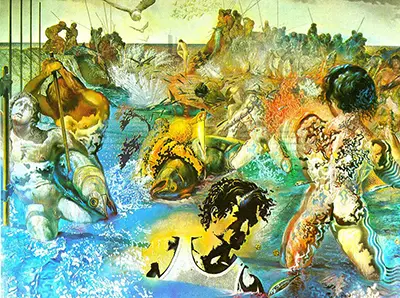Salvador Dali dedicated this painting to Jean Louis, a French painter of the 19th century who was well-known for his depictions of the battle scenes. According to Dali, the painting was his most ambitious artwork due solely to the dedication. The painting is currently owned by Paul Ricard Foundation, which is a private art collection centre in France. Tina Fishing depicts gentlemen acting violently toward Fish. It shows long golden daggers stabbing the aquatic creatures and the once blue waters turning to blood red. To Salvador, the gentlemen and the fish-killing in this painting personify the universe. The Tuna Fishing painting represents the combination of various art forms that Salvador Dali experimented within his early forty years as an artist. Majorly it is considered as part of the great Surrealism movement period. It also includes various styles such as Op and Pop Art, Action Painting, Tachisme, Psychedelic, and Pointillism.
In this painting, Salvador deliberately utilized the style and images of different artistic currents that he had studied before. The gentleman in the foreground of this art was depicted in popular styles in the 1960s, and the antique sculpture inspired the image on the left-hand side. Salvador Dali spent two full summers, 1966 and 1967 to paint the Tuna Fishing. The artwork is full of the Dionysian figures, and the images were a kind of testament which represents the fruit of the 40 years of the devoted search for the means of visual expression. In the painting, he combined all the styles and techniques he had worked on including geometrical abstraction, tachism and refined Pompierism. Tuna Fishing proved significant as his 1930’s soft watch painting, the Persistence of Memory. The unique photographic quality of the Tuna Fishing painting is a tribute to Salvador’s skills and also to his modernity in utilizing projectors to place images directly on the readily available canvas. In this painting, the images range from cinema to Hellenistic Sculpture and mass slaughter of the fish is depicted as a bloodbath that might as well be a gladiatorial scene.

